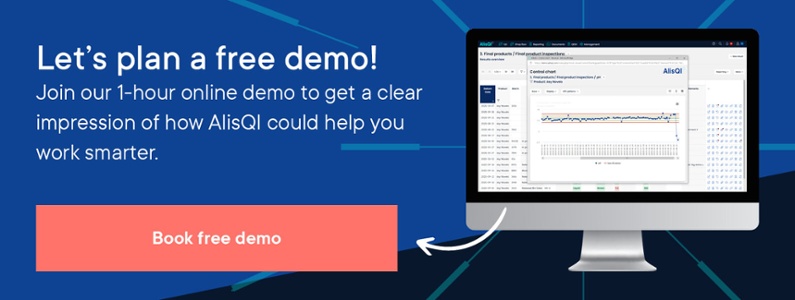Solvers help you monitor quality, apply SPC, manage equipment, and ensure traceability.

How to use the PDCA cycle and improve production
Suppose you’re a manufacturer who has been in business for a couple of years. Despite the popularity of your product, over the past few weeks, you’ve noticed a gradual decrease in your customer satisfaction score. You’ve even received complaints about damaged products and late delivery. So, you decide to try out a new supplier with part of your customers and see how that pans out for you. Working with the new supplier, you hear positive feedback. The customer satisfaction score is also improving. Hence, you decide to only work with the new supplier.
This simple example illustrates a loop in the Plan Do Check Act (PDCA) cycle, a widespread framework for continuous improvement. Quite a few articles are exploring the origin of this change-bringing model considered essential in lean manufacturing. But how does the PDCA cycle work if you’re using quality management software? And how does a smart QMS support the four-stage step-by-step approach? We’re about to find out.
The PDCA cycle – a quick intro
The Plan Do Check Act (PDCA) cycle helps manufacturers to regularly review and improve their strategies to meet their changing needs. It breaks down process management into four concrete, methodical steps:
- Plan
no matter what changes you’re trying to achieve, there is always some planning involved. The planning stage will naturally consist of smaller steps and answering questions around goals, available resources, possible solutions, etc. Your aim is to understand the problem, identify opportunities for improvement, and put together an action plan based on these. - Do
now that you’ve got a plan, it’s time to put it into action. Even if everyone knows their role and responsibilities, the second stage may involve some unforeseen challenges. So, you may want to test changes on a small scale and see if they bring the desired outcome. Remember the manufacturer at the beginning of this article? He used the services of the new supplier with part of his customers to ensure that everything goes smoothly. - Check
did the plan work? In the third stage of the cycle, you get to audit your plan’s execution. Reviewing results and measuring effectiveness will help you decide whether you can continue as planned or if you need to go a different route. Quantifiable data help tremendously with this decision. - Act
has your plan passed the previous stage with flying colors? Then, you’ll get to scale your solution and apply it to the entire organization. While Act is considered the final stage of a loop, the improvement cycle does not end here. PDCA is an iterative, ongoing process aimed at continuous improvement.
The PDCA cycle is versatile and not only limited to carrying out change in a process, product, or service. The step-by-step model can just as well benefit resource management and product development.

PDCA cycle: how does it work if using quality management software?
While it’s not difficult to imagine what an ongoing cycle looks like, picturing how this works when using quality management software may be rather blurry. Our cloud-based quality management system was designed to help manufacturers work smarter, not harder. We automate data collection, data analysis, project management and other routine tasks so that manufacturers can focus on continuous improvement.
To be more specific, this is how AlisQI facilitates the ongoing PDCA cycle:
1. Tools that help you in the Plan stage:
- Analytics for all quality processes to detect deviations
- Root cause analysis (5 times why) to identify both symptoms and causes of deviations
- Calendar to regularly schedule audits and management reviews
- Action lists to define and assign actions and maintain progress
- Built-in risk assessment methodology
2. Tools that help you in the Do stage:
- Automated data recording for which you don’t have to move a finger
- Action lists e.g. CAPA for managing changes
- Updated flow charts and work instructions from DMS
- Workflows for products and processes that isolate changes and create follow-up actions
3. Tools that help you in the Check stage:
- Analytics with time filters to compare pre/post adjustment performance
- Visual snapshots to summarize PDCA results
- Automated triggers to evaluate the effectiveness of actions
- Updated risk assessment to assess the impact of changes
4. Tools that help you in the Act stage:
- Easily communicate changes by means of the DMS centralized documentation and notifications
- Action lists e.g. CAPA for managing changes
- Workflow engine to steer adjusted processes
How does a smart QMS support the PDCA cycle?
“AlisQI supports your PDCA cycle with ease,’’ said Geert Segers, QESH Manager at Lamers HTS. ‘’You’ve got your processes, your deviations, your moments of evaluation, and your improvement cycle that can all be steered from AlisQI. The whole management process is much better supported.”
Lamers HTS implemented AlisQI to boost its overall quality and gain access to more analysis and actionable data. Looking at the before and after implementing AlisQI scenarios, the QESH Manager recommends the platform that has been helping his team to engage with quality management more intensively.
Do you also want to be more involved and actively use the PDCA cycle to improve production? Request a demo and we will reach out to discuss your needs and AlisQI’s capabilities.


